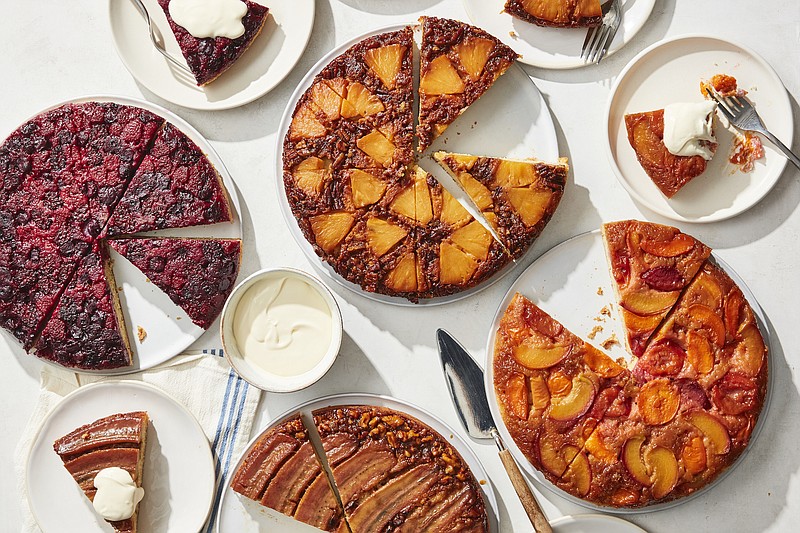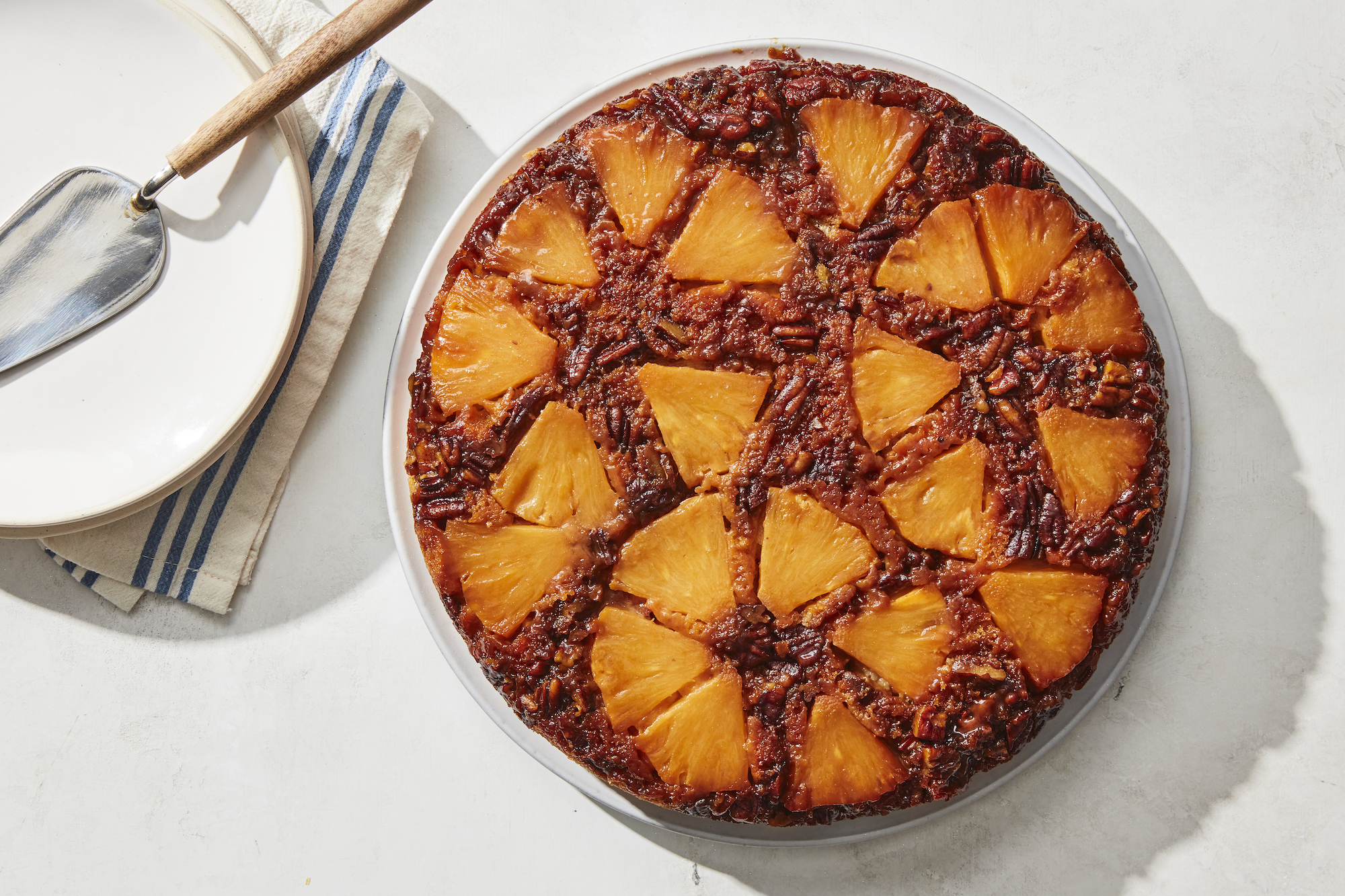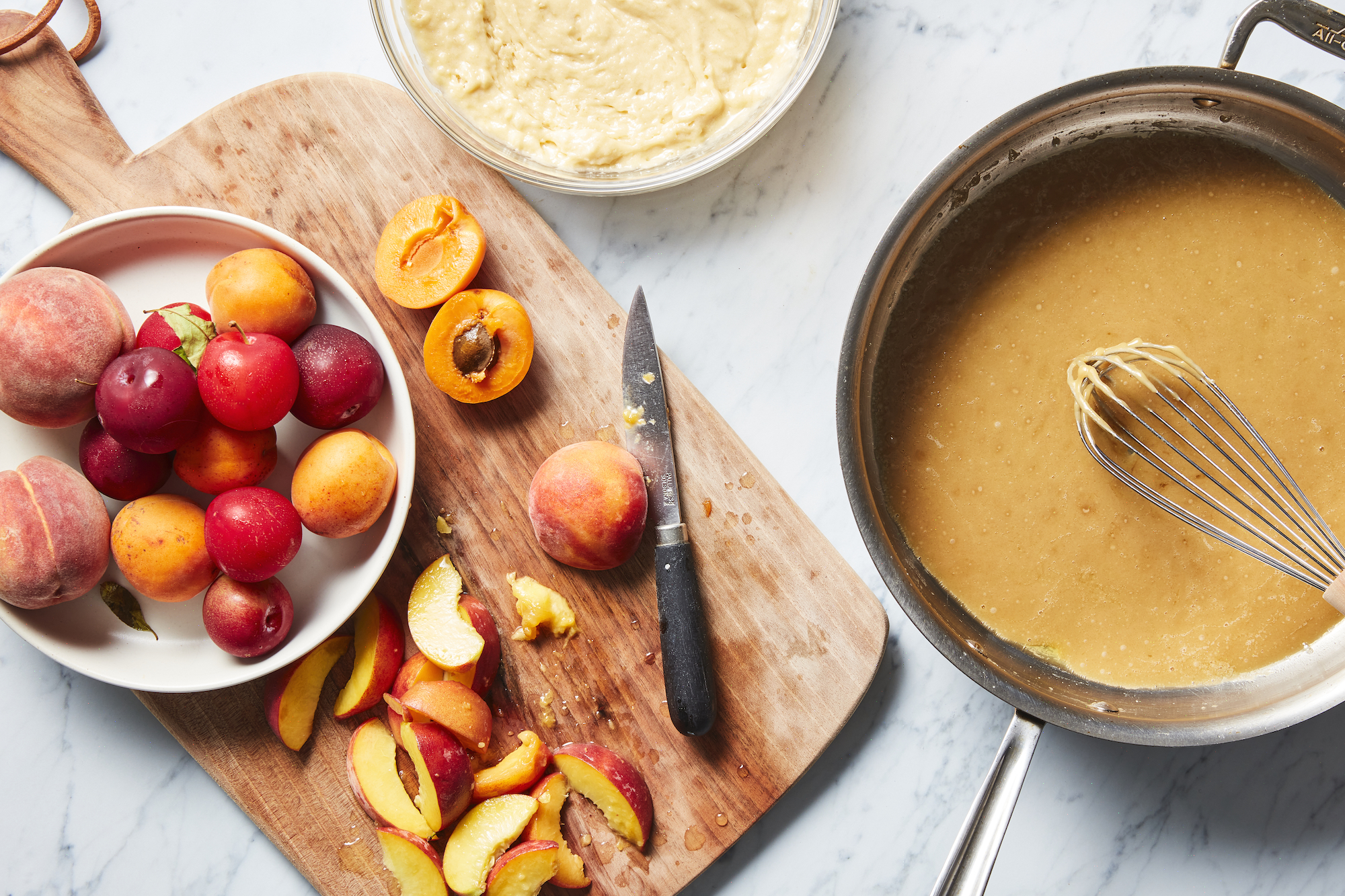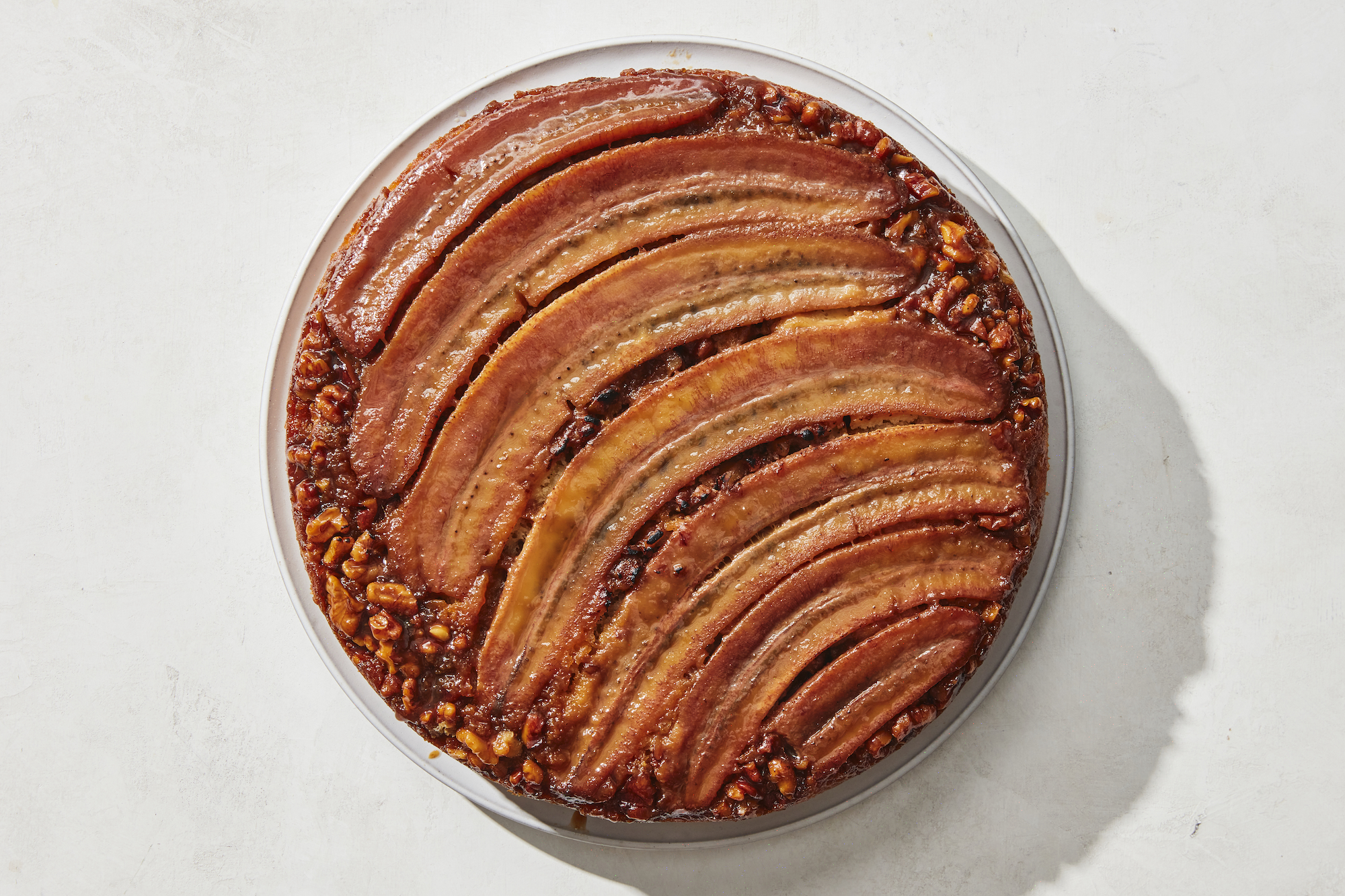With glossy yellow rings bull's-eyed by neon red cherries, pineapple upside-down cake is a beloved American dessert: homey, nostalgic, boldly geometric. Ever since the recipe was popularized in the 1920s, it's become so entrenched in our confectionary consciousness that an upside-down cake made with anything else seems like a mere afterthought.
But other fruit -- juicy summer peaches, apricots, plums and nectarines; mounds of purple berries; velvety bananas -- can make upside-down cakes as good or even better than the usual pineapple. And they're exactly the thing to bake right now, especially if you're wondering what to do with that surfeit of stone fruits and berries leaking sticky nectar all over your kitchen counter.
Upside-down cakes don't require the pristine fruit you'd want for a shortcake or tart. No matter how wrinkled your peaches or sagging your blueberries, once they've been caramelized and baked under batter, they'll become syrupy and colorful, a shimmering crown without further need of embellishment.
Just as essential as an upside-down cake's ability to put languishing fruit to use is its ease. The batter is a cinch to whisk up in one bowl, making it faster and easier than a pie or galette crust. Then you can bake the cake in the same skillet you used for the fruit -- perfect for rented houses where kitchen equipment is sparse, the parchment paper nonexistent.
One of the earliest recipes called "upside-down cake" was published in 1923 in the now-defunct Syracuse Herald. Prunes were the fruit in question, arranged over brown sugar and butter, and speckled with walnuts. Other versions, using apricots and pitted sour cherries, were also fashionable in the early 20th century.
Pineapple became the go-to in 1926 when Dole sponsored a recipe contest. There were 60,000 entries; 2,500 were for some version of pineapple upside-down cake.
Pineapple has remained on the top of the upside-down heap ever since. In my twist on the classic, I nixed the cherries, substituted fresh pineapple for canned and added pecans for texture. (I also used nuts in my banana variation, which has Bananas Foster-like vibes, but with the happy bonus of some cake and a crunch.)
Although the recipe for upside-down cake is straightforward, there are some best practices for the most tender crumb and a fruit topping that's just sweet enough without being all cloying.
The first is to caramelize the sugar before adding the fruit. Many vintage recipes skip this step in favor of simplicity, instead just melting the butter, then sprinkling the sugar on top. While this works, it results in a neutral sweetness with a muted caramel character.
Deeply caramelizing the sugar before adding the fruit tempers it, bringing out a mild bitterness and adding layers of nutty complexity, and it takes only a few minutes. Don't worry if the sugar clumps and seizes, it will melt again when you bake the cake, turning silky smooth.
Another tip is to bake the cake longer than you would a regular butter cake. This is because of the moisture in the fruit, particularly stone fruit and berries, which have high water contents that can make the crumb soggy. The cake surface should be well browned all over, with dark edges that yield a slight crunch. A toothpick inserted in the middle should emerge without any crumbs.
Always let your cake rest for 10 to 15 minutes before inverting it onto a platter to let fruit and caramel firm up a little. But don't let it go longer than that, or the caramel may cool and glue the fruit to the pan. Of course, you can always pry it out and put it back on top of the cake. Then, slice, serve and get ready to fall head over heels for upside-down cake.
Pineapple Upside-Down Cake With Pecans
Yield: 1 (10-inch) cake
Total time: 1 hour, plus cooling
For the fruit topping:
4 tablespoons unsalted butter
1/3 cup light brown sugar
1 1/2 to 2 1/2 teaspoons freshly squeezed lemon juice (see tips)
1/4 teaspoon fine sea salt
1 pound peeled pineapple, cut into 1/2-inch slices (3 cups; see tips)
1/2 cup coarsely chopped pecans
For the cake:
1/2 cup unsalted butter, melted and cooled, plus more for greasing
1 cup sugar
1 tablespoon vanilla extract
1 teaspoon finely grated lemon zest
2 large eggs, at room temperature
1/2 cup sour cream or plain whole-milk yogurt
1 1/2 teaspoons baking powder
1/4 teaspoon baking soda
3/4 teaspoon fine sea salt
1 1/2 cups all-purpose flour
Heat oven to 350 degrees.
Make the topping: In an oven-safe 10-inch skillet, melt butter over medium heat. Add the brown sugar, lemon juice and salt, and whisk until the brown sugar melts, 1 to 2 minutes.
Let cook, whisking constantly, until the mixture starts to smell like caramel and darkens slightly, about 1 minute longer. (Don't walk away or the mixture may burn.) The mixture will clump and separate, but that's OK.
Add fruit and nuts, gently tossing to coat with the caramel. Remove from heat and arrange fruit into an even layer on bottom of skillet. Ignore any sugar clumps; they will dissolve during baking.
Make the cake: In a large bowl, whisk together the melted butter, sugar, vanilla and lemon zest until thoroughly combined. Whisk in eggs, one at a time. Add sour cream, and whisk until well mixed. Sprinkle baking powder, baking soda and salt into the batter, one at a time, and whisking vigorously after each addition. Using a rubber spatula, gently fold in flour until just incorporated. The mixture will be lumpy, but that's OK. Don't overmix. Scrape batter into the skillet over the fruit and spread evenly.
Bake until surface is deeply browned all over (with darker brown edges) and the fruit is lightly bubbling along the sides of the skillet, 35 to 45 minutes, rotating halfway through. A toothpick inserted into cake will come out clean.
Once the cake is out of the oven, immediately run a butter knife or offset spatula along the edge of the skillet. Let sit for 10 to 15 minutes to cool slightly. Carefully invert cake onto serving platter. If some fruit or nuts stick to bottom of the skillet, gently remove them using offset spatula or knife and place back onto cake. Let cake cool until the fruit topping sets, at least 30 minutes to 1 hour, before serving. Cake is best served on the day it is baked.
Tips:
-- Since you'll need the lemon juice for the topping and the grated zest for the cake, it's best to zest the lemon before you cut it and juice it.
-- You can substitute an equal amount of drained canned pineapple for fresh.
-- By Melissa Clark
Peach Upside-Down Cake
Yield: 1 (10-inch) cake
Total time: 1 hour, plus cooling
For the fruit topping:
4 tablespoons unsalted butter
1/3 cup light brown sugar
1 1/2 teaspoons freshly squeezed lemon juice (see tip)
1/4 teaspoon fine sea salt
3 cups sliced peaches, or use 3 cups sliced nectarines, plums or apricots (about 1 1/4 pounds before pitting)
For the cake:
1/2 cup unsalted butter, melted and cooled, plus more for greasing the pan
1 cup sugar
1 tablespoon vanilla extract
1 teaspoon finely grated lemon zest
2 large eggs, at room temperature
1/2 cup sour cream or plain whole-milk yogurt
1 1/2 teaspoons baking powder
3/4 teaspoon fine sea salt
1/4 teaspoon baking soda
1 1/2 cups all-purpose flour
Heat oven to 350 degrees.
Make the topping: In an oven-safe 10-inch skillet, melt butter over medium heat. Add the brown sugar, lemon juice and salt, and whisk until the brown sugar melts, 1 to 2 minutes.
Let cook, whisking constantly, until the mixture starts to smell like caramel and darkens slightly, about 1 minute longer. (Don't walk away or the mixture may burn.) The mixture will clump and separate, but that's OK.
Add fruit, gently tossing to coat with the caramel. Remove from the heat, and arrange fruit into an even layer on the bottom of the skillet. Ignore any sugar clumps; they will dissolve during baking.
Make the cake: In a large bowl, whisk together the melted butter, sugar, vanilla and lemon zest until thoroughly combined. Whisk in eggs, one at a time. Add sour cream, and whisk until well mixed. Sprinkle baking powder, salt and baking soda into the batter, one at a time, whisking vigorously after each addition.
Using a rubber spatula, gently fold in flour until just incorporated. The mixture will be lumpy, but that's OK. Don't overmix. Scrape batter into the skillet over the fruit, and spread evenly.
Bake until surface is deeply browned all over (with darker brown edges) and the fruit is lightly bubbling around the sides of the skillet, 35 to 45 minutes, rotating halfway through. A toothpick inserted into cake will come out clean.
Once the cake is out of the oven, immediately run a butter knife or offset spatula around the edge of the skillet. Let sit for 10 to 15 minutes to cool slightly. Carefully invert cake onto serving platter. If some fruit sticks to bottom of skillet, gently remove using offset spatula or knife and place back onto cake. Let cake cool until the fruit topping sets, at least 30 minutes to 1 hour, before serving. Cake is best served on the day it is baked.
Tip: Since you'll need the lemon juice for the topping and the grated zest for the cake, it's best to zest the lemon before you cut it and juice it.
-- By Melissa Clark
Berry Upside-Down Cake
Yield: 1 (10-inch) cake
Total time: 1 hour, plus cooling
For the fruit topping:
4 tablespoons unsalted butter
1/3 cup light brown sugar
1 tablespoon freshly squeezed lemon juice (see tip)
1/4 teaspoon fine sea salt
3 cups fresh or frozen mixed berries (about 1 pound), quarter the strawberries, if using
For the cake:
1/2 cup unsalted butter, melted and cooled, plus more for greasing
1 cup sugar
1 tablespoon vanilla extract
1 teaspoon finely grated lemon zest
2 large eggs, at room temperature
1/2 cup sour cream or plain whole-milk yogurt
1 1/2 teaspoons baking powder
3/4 teaspoon fine sea salt
1/4 teaspoon baking soda
1 1/2 cups all-purpose flour
Heat oven to 350 degrees.
Make the topping: In an oven-safe 10-inch skillet, melt butter over medium heat. Add the brown sugar, lemon juice and salt, and whisk until the brown sugar melts, 1 to 2 minutes.
Let cook, whisking constantly, until the mixture starts to smell like caramel and darkens slightly, about 1 minute longer. (Don't walk away or the mixture may burn.) The mixture will clump and separate, but that's OK.
Add fruit, gently tossing to coat with the caramel. Remove from heat and arrange fruit into an even layer on bottom of skillet. Ignore any sugar clumps; they will dissolve during baking.
Make the cake: In a large bowl, whisk together the melted butter, sugar, vanilla and lemon zest until thoroughly combined. Whisk in eggs, one at a time. Add sour cream, and whisk until well mixed. Sprinkle baking powder, salt and baking soda into the batter, one at a time, and whisking vigorously after each addition.
Using a rubber spatula, gently fold in flour until just incorporated. The mixture will be lumpy, but that's OK. Don't overmix. Scrape batter into the skillet over the fruit and spread evenly.
Bake until the surface is deeply browned all over (with darker brown edges) and the fruit is lightly bubbling along the sides of the skillet, 35 to 45 minutes, rotating halfway through. A toothpick inserted into cake will come out clean.
Once the cake is out of the oven, immediately run a butter knife or offset spatula around the edge of the skillet. Let sit for 10 to 15 minutes to cool slightly. Carefully invert cake onto serving platter. If some berries stick to bottom of skillet, gently remove using offset spatula or knife and place back onto cake. Let cake cool until the fruit topping sets, at least 30 minutes to 1 hour, before serving. Cake is best served on the day it is baked.
Tip: Since you'll need the lemon juice for the topping and the grated zest for the cake, it's best to zest the lemon before you cut it and juice it.
-- By Melissa Clark
Banana Upside-Down Cake
Yield: 1 (10-inch) cake
Total time: 1 hour, plus cooling
For the fruit topping:
4 tablespoons unsalted butter
1/3 cup light brown sugar
2 teaspoons freshly squeezed lemon juice (see tip)
1/4 teaspoon fine sea salt
1 pound bananas (about 3 large bananas), sliced lengthwise into 1/2-inch-thick planks
1/2 cup coarsely chopped walnuts or pecans
For the cake:
1/2 cup unsalted butter, melted and cooled, plus more for greasing the pan
1 cup sugar
1 tablespoon vanilla extract
1 teaspoon finely grated lemon zest
2 large eggs, at room temperature
1/2 cup sour cream or plain whole-milk yogurt
1 1/2 teaspoons baking powder
3/4 teaspoon fine sea salt
1/4 teaspoon baking soda
1 1/2 cups all-purpose flour
Heat oven to 350 degrees.
Make the topping: In an oven-safe 10-inch skillet, melt butter over medium heat. Add the brown sugar, lemon juice and salt, and whisk until the brown sugar melts, 1 to 2 minutes.
Let cook, whisking constantly, until the mixture starts to smell like caramel and darkens slightly, about 1 minute longer. (Don't walk away or the mixture may burn.) The mixture will clump and separate, but that's OK.
Add bananas and nuts, gently tossing to coat with the caramel. Remove from heat, and arrange fruit into an even layer on bottom of skillet. Ignore any sugar clumps; they will dissolve during baking.
Make the cake: In a large bowl, whisk together the melted butter, sugar, vanilla and lemon zest until thoroughly combined. Whisk in eggs, one at a time. Add sour cream, and whisk until well mixed. Sprinkle baking powder, salt and baking soda into the batter, one at a time, and whisking vigorously after each addition.
Using a rubber spatula, gently fold in flour until just incorporated. The mixture will be lumpy, but that's OK. Don't overmix. Scrape batter into the skillet over the fruit and spread evenly.
Bake until surface is deeply browned all over (with darker brown edges) and the fruit is lightly bubbling around the sides of the skillet, 35 to 45 minutes, rotating halfway through. A toothpick inserted into cake will come out clean.
Once the cake is out of the oven, immediately run a butter knife or offset spatula around the edge of the skillet. Let sit for 10 to 15 minutes to cool slightly. Carefully invert cake onto serving platter. If some fruit or nuts stick to bottom of skillet, gently remove them using an offset spatula or knife and place them back onto cake. Let the cake cool until the fruit topping sets, at least 30 minutes to 1 hour, before serving. Cake is best served on the day it is baked.
Tip: Since you'll need the lemon juice for the topping and the grated zest for the cake, it's best to zest the lemon before you cut it and juice it.
-- By Melissa Clark




